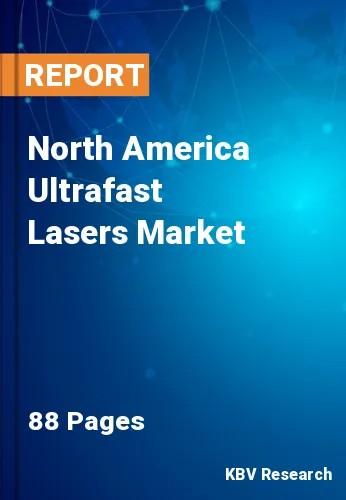The North America Ultrafast Lasers Market would witness market growth of 13.7% CAGR during the forecast period (2022-2028).
When McPherson et al. successfully created harmonic emission up to the 17th order at 248 nm in neon gas in 1987, they made the first observation of it. HHG is observed by concentrating a near-IR pulse at intensities of (1013–1014) W/cm2 into a noble gas, which causes coherent pulses to be produced in the XUV–soft X-ray (100–1 nm) portion of the spectrum.
As opposed to huge free electron-laser facilities, it is feasible on a laboratory scale also called tabletop systems. In terms of the three-step paradigm, high harmonic generation in atoms is well understood (ionization, propagation, and recombination). An electron penetrates through the barrier and ionizes as a result of the powerful laser field's modification of the atom's Coulomb potential.
Propagation: The free electron picks up speed and momentum in the laser field. Recombination: The electron is driven back toward the ionic parent as the field flips, releasing a very high-energy photon as it does so. Activation or probe wavelengths need to be different for various spectroscopic experiments. Due to this, frequency conversion methods are frequently employed to increase the operational spectrum of laser light sources that are already in use.
For British Columbia's economy to diversify and grow in the future, manufacturing is essential. It illustrates the potential of British Columbia to develop new products and production techniques. Among the manufacturing sub-sectors with the fastest growth rates are pharmaceuticals and medicines, equipment, ship and boatbuilding, and electronic goods and components. It is also closely related to British Columbia's advantages in forestry, agriculture, and mining, adding to the value of the region's plentiful natural resources.
The US market dominated the North America Ultrafast Lasers Market by Country in 2021, and would continue to be a dominant market till 2028; thereby, achieving a market value of $922.9 million by 2028. The Canada market is poised to grow at a CAGR of 16.3% during (2022 - 2028). Additionally, The Mexico market would witness a CAGR of 15.3% during (2022 - 2028).
Based on Pulse Duration, the market is segmented into Femtosecond and Picosecond. Based on End User, the market is segmented into Medical, Industrial, Consumer Electronics, Automotive, Aerospace & Defense, and Others. Based on Type, the market is segmented into Fiber Lasers, Mode-Locked Lasers, Titanium-Sapphire Lasers, and Others. Based on Application, the market is segmented into Micromachining, Scientific Research, Medical Device Fabrication, Cardiovascular Stent Manufacturing, Bio-Imaging, and Others. Based on countries, the market is segmented into U.S., Mexico, Canada, and Rest of North America.
Free Valuable Insights: The Global Ultrafast Lasers Market is Predict to reach $3.7 Billion by 2028, at a CAGR of 15.3%
The market research report covers the analysis of key stake holders of the market. Key companies profiled in the report include Lumentum Holdings, Inc., NKT Photonics A/S (NKT A/S), TRUMPF GmbH + Co. KG, Coherent, Inc.(II-VI Incorporated), IMRA America, Inc. (Aisin Corporation), Amplitude Systemes, Clark-MXR, Inc., DPSS Lasers Inc., and Wuhan Huaray Precision Laser Co., Ltd.
By Pulse Duration
By End User
By Type
By Application
By Country
Our team of dedicated experts can provide you with attractive expansion opportunities for your business.

